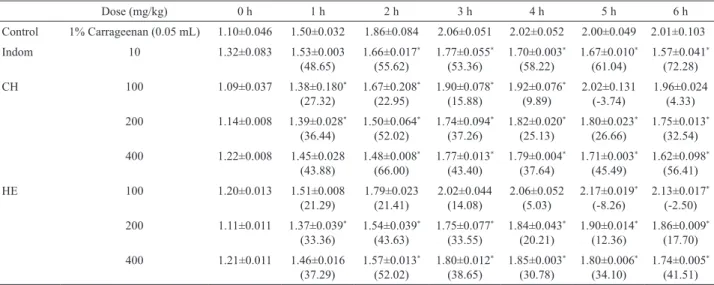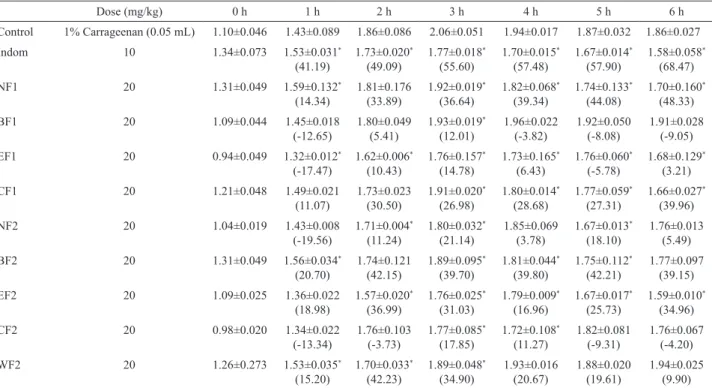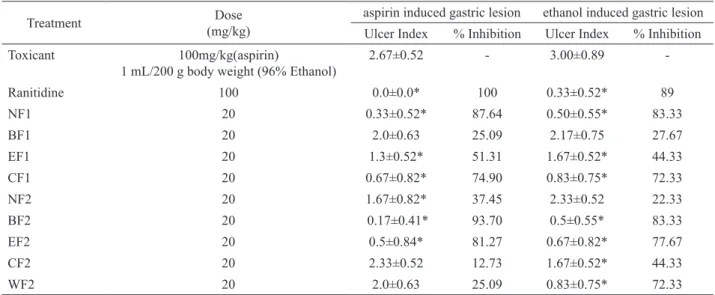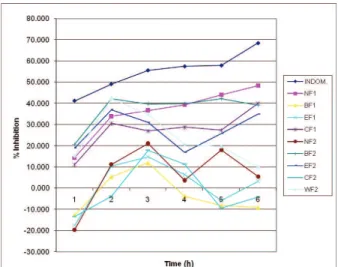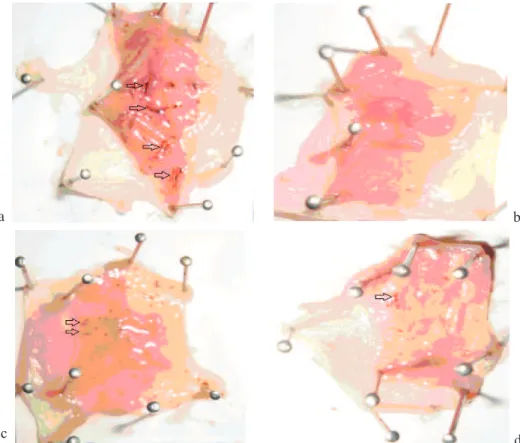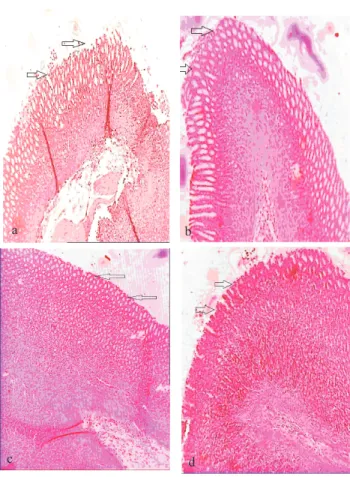Article
ISSN 0102-695X
http://dx.doi.org/10.1590/S0102-695X2011005000175
Received 12 Aug 2010 Accepted 20 May 2011 Available online 23 Sep 2011
Nagesh S. Tour,
1,*Gokul S. Talele
21R. C. Patel Institute of Pharmaceutical Education and Research, India, 2Nashik Gramin Shikshan Prasarak Mandal’s College of Pharmacy, India.
Abstract: In recent years, a widespread search has been launched to identify new antiinflammatory and antiulcer-drugs from natural sources. The study was aimed at evaluating the antiinflammatory and antiulcer activity of chloroform extract (CH) and hydroalcoholic extract (HE) of the stem bark of Calotropis procera (Aiton) W.T. Aiton, Apocynaceae, obtained successively by cold maceration. The antiinflammatory effect of the CH and HE extracts of the stem bark of the C. procera against carrageenan-induced paw oedema and also its antiulcer activity by using two acute models: Aspirin (100 mg/kg, p.o.) and ethanol (96%, 1 mL/200 g) in albino rats have been studied and found to be significant at 200 and 400 mg/kg when compared to the standard drugs. As a part of investigations to obtain compounds with antiinflammatory and antiulcer activity in this work, a bioassay was carried out with fractions obtained from chloroform extract with n-hexane (NF1), 1-butanol (BF1), ethyl acetate (EF1) and chloroform (CF1). The hydroalcoholic extract (HE) of the stem bark was fractionated with n-hexane (NF2), 1-butanol (BF2), ethyl acetate (EF2), chloroform (CF2) and water (WF2). The fractions were freeze-dried and evaluated for its antiinflammatory and antiulcer activity. Fractions NF1, CF1, BF2 and EF2 (20 mg/kg) showed significant antiinflammatory and antiulcer activity. The results obtained for antiulcer activity were also supported well by the histopathological examination of the open excised rat stomach. Further experiments are underway to determine which phytoconstituents are involved in antiinflammatory and antiulcer activities as well as mechanisms involved in gastroprotection. Keywords:
antiinflammatory Asclepiadaceae Calotropis procera gastric antiulcer healing effect stem bark
Introduction
Currently varieties of steroidal and nonsteroidal antiinl ammatory drugs (NSAID) are being used for treating inl ammatory diseases. Gastrointestinal bleeding and ulceration are the most common and severe adverse effects associated with NSAID (Fung & Kirschenbaum, 1999). Because of these side effects, safer compounds are needed. The gastric mucosal lesions formed by ethanol, were reported as by interfering with the gastric defensive mechanisms (Kinoshita et al., 1995). Although there are many products used for the treatment of gastric ulcers, most of these drugs produce several adverse reactions (Ariyphisi et al., 1986). To investigate the effects of drugs on the acute phase of inl ammation, models induced by pro-inl ammatory agents such as carrageenan, dextran, formaldehyde, serotonin histamine and bradykinin in rat paws are employed (Campos et al., 1995). Carrageenan, a mucopolysaccaride, is perhaps the most commonly-used and well-studied of these phlogistics (Leme et al., 1973), producing a maximal oedema in 3 h. While the carrageenan model is typically associated with activation of the cyclooxygenase pathway and is sensitive to
glucocorticoids and prostaglandin synthesis antagonists, the early phase of the carrageenan response is due to the release of serotonin and histamine (DiRosa et al., 1971).
Due to the growing interest in the alternative therapies in recent years, the use of natural products especially those derived from plants are in demand. (Rates, 2001; Schmeda-Hirschmann & Yesilada, 2005). Calotropis procera (Aiton) W.T. Aiton, Apocynaceae, stem bark extract is one such herbal drug currently undertaken in the present study primarily to evaluate its antiinl ammatory and antiulcerogenic potential in rats. C. procera is a medicinal plant distributed in north, western and central India. This plant is commonly known as ‘Madar’ (Nadkarni, 2000). The latex of the plant is used for treating epilepsy, inl ammation, painful joints and swellings. Leaves are used as antibacterial and antifungal and to alleviate ear pain. Root bark is used in skin diseases and as an anthelmentic. Flowers are used in loss of appetite. The plant contains Cardenolides, proceragenin (The Wealth of India, 1992). The plant is used in treating eye troubles (Kirtikar & Basu, 2006).
Calotropis procera as a medicinal plant, interest in this plant is justiiable for antiinlammatory and antiulcer diseases.
Materials and Methods
Plant material
Calotropis procera (Aiton) W.T. Aiton, Apocynaceae, stem bark was collected from Dhule district, Maharashtra, India, during the month of May 2009. It was identiied and authenticated by T. Chakraborty, Joint Director, Botanical Survey of India, Pune, India. A voucher specimen has been deposited at the Herbarium of the Centre (V. No: CAPNAS1).
Preparation of the extract
Stem bark was collected, shade-dried and powdered mechanically. About 1000 g of the stem bark powder was extracted with 2000 mL of chloroform and successively with 2000 mL of hydroalcohol by maceration at room temperature for 48 h using a mechanical shaker. The extracts were dried at 40 °C under vacuum by using Rota Evaporator (Buchi Rotavapor R-215) and the yield of the extracts was 50 and 66 g respectively. The chloroform extract (CH) was fractionated with n-hexane (NF1), 1-butanol (BF1), ethyl acetate (EF1) and chloroform (CF1). The fractions were freeze-dried and were equivalent to 35.06, 24.45, 8.34 and 7.95% respectively of the dry CH. The hydroalcoholic extract (HE) of the stem bark was fractionated with n-hexane (NF2), 1-butanol (BF2), ethyl acetate (EF2), chloroform (CF2) and water (WF2). The fractions were freeze-dried and were equivalent to 4.75, 10.25, 5.6, 15.9 and 46% respectively of the dry HE.
For dosing, the extracts and fractions were uniformly suspended in 1% carboxymethyl cellulose (CMC) dissolved in water and administered depending upon the experimental design.
Phytochemical screening
In preliminary phytochemical study, the chloroform extract showed the presence of triterpenoids and steroids whereas successive hydroalcoholic extract showed the presence of polyphenols and tannins.
Animals
Albino rats of Wistar strain of either sex weighing between 150 and 200 g were used. They were housed in standard cages at room temperature (25±2 °C) and provided with food and water ad libitum. The study was conducted after obtaining institutional ethical
Committee clearance (RCPIPER/IAEC/2009-10/04).
Selection of dose of the extract
LD50 was done as per OECD guidelines (Organization for Economic Cooperation and Development) for ixing the dose for biological evaluation. The LD50 of the extract as per OECD guidelines falls under class four values with no signs of acute toxicity at 2000 mg/kg. The biological evaluation was carried out at doses of 100, 200 and 400 mg/kg body weight.
Antiinlammatory activity of the extracts and fractions
of Calotropis procera in carrageenan-induced rat paw oedema
Eight groups of six animals per group were used. The plant extract was administered orally at doses 100, 200, 400 mg/kg as well as 10 mg/kg of indomethacin. Control rats received suspension of 1% CMC in distilled water. The administration of extract and drugs was 30 min prior to injection of 0.05 mL, 1% carrageenan in the right hindpaw subplantar of each rat (Lanhers et al., 1991). Remaining groups were treated with the CH and HE extracts at the oral dose of 100, 200, 400 mg/ kg, 1 h before carrageenan injection. The paw volume was measured using a plethysmometer, before injection and 6 times at 1-h intervals (Birch et al., 1992). The antiinlammatory activity in animals receiving CH and HE extracts was compared with that in indomethacin and control groups.
Albino rats were divided into eleven groups of six rats each for evaluation of fractions. Antiinlammatory activity was evaluated as mentioned above. All samples of the fractions were given at 20 mg/kg dose.
Antiulcer activity of the extracts and fractions of
Calotropis procera
Aspirin -induced gastric ulcer in albino rats
Albino rats were divided into eight groups of six rats each. All the rats were starved for 24 h. After the fasting period, aspirin (100 mg/kg, p.o.) was given. All samples of the plant extracts were given 30 min prior to aspirin at three different doses i.e. 100, 200 and 400 mg/ kg. The animals were sacriiced 5 h after the treatment. Stomach was cut open in the greater curvature and ulcer scoring was done by using magnifying lens and the ulcer scored according to its severity in comparison with that of standard. Ulcer score was recorded as mentioned in histopathological studies were performed to conirm the ulcer score (Hemmati et al., 1973).
for antiulcer activity as mentioned above at 20 mg/kg dose.
Gastric lesions induced by ethanol
Albino rats were divided into eight groups of six rats each. Rats, fasted for 24 h were used. After the fasting period, ethanol (96%, 1 mL/200 mg body weight) was given orally. All samples of the plant extracts were given 30 min. prior to ethanol treatment at three different doses i.e. 100, 200 and 400 mg/kg. The animals were sacriiced under anaesthesia using ether, 1 h after ethanol treatment. The stomach of each animal was excised and opened along the greater curvature. Ulcer score was recorded as mentioned in Histopathological studies were performed to conirm the ulcer score (Zhuikova et al. 2004).
All samples of the fractions were evaluated for antiulcer activity as mentioned above at 20 mg/kg dose.
Ulcer score
The gastric mucosa was examined for ulcers by magnifying lens and the ulcer scored according to its severity in comparison with that of standard. Ulcer score was recorded as follows: 0, normal, no ulcer; 1, isolated haemorrhagic spot; 2, dense haemorrhagic spot; 3, small ulcer; 4, large ulcer; 5, perforation. Histopathological studies were performed to conirm the ulcer score (Barrett et al., 1953).
Histopathological evaluation of aspirin -induced and
ethanol induced ulcers
Stomachs were immersed in a 10% formalin solution for histopathological examination following the assessment of ulcer score. The central part of the
damaged (or) ulcerated tissue (if present) was cut in half along the long diameter. If the stomach was protected from the damage then the section was taken from the basal part. After the standard processing, the wet tissue was embedded in parafin and cut into 5 µm thick section in a rotary micrometer. The sections stained with haematoxylin-eosin, mounted with Canada balsam were examined under the microscope for histopathological changes such as oedema, inlammation, iniltration and erosion.
Statistical analysis
The data are reported as mean±SEM, and were compared using one-way analysis of variance (ANOVA), followed by Dunnet’s pairwise test, with p values <0.05 being considered signiicant.
Results
Antiinlammatory effect of extracts on carageenan- induced inlammation
Both CH and HE of C. procera were found to have antiinflammatory effects. The antiinflammatory effect of indomethacin was found to be 55.62%, while the most potent extract was found to be CH of C. procera at the dose of 400 mg/kg body wt., with 66% antiinflammatory effect (2 h following carrageenan injection). The same extract in a dose of 100 and 200 mg/kg body weight exerted 22.95% and 52.02% of antiinflammatory effect. For the HE of C. procera, antiinflammatory effects of 21.41% for 100, 43.63% for 200 and 52.02% for 400 mg/kg doses were found 2 h following carrageenan injection as mentioned in Table 1.
Table 1. The effects of Calotropis procera stem bark extracts in chloroform (CH) and hydroalcohol (HE) and indomethacin (Indom.) in carrageenan-induced acute paw oedema (mL).
Dose (mg/kg) 0 h 1 h 2 h 3 h 4 h 5 h 6 h
Control 1% Carrageenan (0.05 mL) 1.10±0.046 1.50±0.032 1.86±0.084 2.06±0.051 2.02±0.052 2.00±0.049 2.01±0.103
Indom 10 1.32±0.083 1.53±0.003
(48.65) 1.66±0.017* (55.62) 1.77±0.055* (53.36) 1.70±0.003* (58.22) 1.67±0.010* (61.04) 1.57±0.041* (72.28)
CH 100 1.09±0.037 1.38±0.180*
(27.32) 1.67±0.208* (22.95) 1.90±0.078* (15.88) 1.92±0.076* (9.89) 2.02±0.131 (-3.74) 1.96±0.024 (4.33)
200 1.14±0.008 1.39±0.028*
(36.44) 1.50±0.064* (52.02) 1.74±0.094* (37.26) 1.82±0.020* (25.13) 1.80±0.023* (26.66) 1.75±0.013* (32.54)
400 1.22±0.008 1.45±0.028
(43.88) 1.48±0.008* (66.00) 1.77±0.013* (43.40) 1.79±0.004* (37.64) 1.71±0.003* (45.49) 1.62±0.098* (56.41)
HE 100 1.20±0.013 1.51±0.008
(21.29) 1.79±0.023 (21.41) 2.02±0.044 (14.08) 2.06±0.052 (5.03) 2.17±0.019* (-8.26) 2.13±0.017* (-2.50)
200 1.11±0.011 1.37±0.039*
(33.36) 1.54±0.039* (43.63) 1.75±0.077* (33.55) 1.84±0.043* (20.21) 1.90±0.014* (12.36) 1.86±0.009* (17.70)
400 1.21±0.011 1.46±0.016
(37.29) 1.57±0.013* (52.02) 1.80±0.012* (38.65) 1.85±0.003* (30.78) 1.80±0.006* (34.10) 1.74±0.005* (41.51)
Antiinlammatory effect of fractions on carageenan-induced inlammation
For the inflammation of acute phase, carrageenan-induced paw-volume increase, and the effects of the indomethacin and C. procera fractions were evaluated. The indomethacin showed 49.09% of antiinflammatory activity in 2 h after carrageenan injection. The fractions NF1, CF1, BF2, and EF2 showed inhibition of 33.89, 30.50, 42.15, and 36.99% respectively antiinflammatory activity in 2 h following carrageenan injection as given in Table 2.
Antiulcerogenic effect of extracts on aspirin-induced gastric ulcer
The doses of 200 and 400 mg/kg of the CH and HE showed negligible ulcer score, which was significant when compared to the control animals. 59.01 and 82.33% inhibition was observed by 200 and 400 mg/kg of the CH. 53.00 and 70.67% inhibition was observed by 200 and 400 mg/kg of the HE. Ulcer score were confirmed by performing histopathological studies. There was no ulceration and cell necrosis. The gastric mucosa was normal which was comparable to the Ranitidine (Table 3).
Table 3. Effect of Calotropis procera stem bark extracts in chloroform (CH) and hydroalcohol (HE) on % inhibition of ulcer induced by aspirin and ethanol.
Treatment Dose
(mg/kg)
aspirin induced gastric lesion ethanol induced gastric lesion Ulcer Index % Inhibition Ulcer Index % Inhibition
Toxicant 100 mg/kg (aspirin)
1 mL/200 g body weight (96% Ethanol)
2.83±0.41 - 3.17±0.98
-Ranitidine 100 0.0±0.0* 100 0.33±0.52* 89.59
CH 100 200 400 2±0.63 1.16±0.75* 0.50±0.55* 29.33 59.01 82.33 2.33±0.52 1.66±0.52* 0.67±0.52* 26.50 47.63 78.86 HE 100 200 400 2.17±0.75 1.33±1.03* 0.83±0.75* 23.32 53.00 70.67 2.33±1.03 1.83±0.41* 1.17±0.75* 26.50 42.27 63.09
Results are mean±SEM for six rats. Statistical comparison was performed using one-way analysis of variance (ANOVA) followed by Dunnet’s test.
*Statistically signiicant p<0.05 (in comparison with control).
Dose (mg/kg) 0 h 1 h 2 h 3 h 4 h 5 h 6 h
Control 1% Carrageenan (0.05 mL) 1.10±0.046 1.43±0.089 1.86±0.086 2.06±0.051 1.94±0.017 1.87±0.032 1.86±0.027
Indom 10 1.34±0.073 1.53±0.031*
(41.19) 1.73±0.020* (49.09) 1.77±0.018* (55.60) 1.70±0.015* (57.48) 1.67±0.014* (57.90) 1.58±0.058* (68.47)
NF1 20 1.31±0.049 1.59±0.132*
(14.34) 1.81±0.176 (33.89) 1.92±0.019* (36.64) 1.82±0.068* (39.34) 1.74±0.133* (44.08) 1.70±0.160* (48.33)
BF1 20 1.09±0.044 1.45±0.018
(-12.65) 1.80±0.049 (5.41) 1.93±0.019* (12.01) 1.96±0.022 (-3.82) 1.92±0.050 (-8.08) 1.91±0.028 (-9.05)
EF1 20 0.94±0.049 1.32±0.012*
(-17.47) 1.62±0.006* (10.43) 1.76±0.157* (14.78) 1.73±0.165* (6.43) 1.76±0.060* (-5.78) 1.68±0.129* (3.21)
CF1 20 1.21±0.048 1.49±0.021
(11.07) 1.73±0.023 (30.50) 1.91±0.020* (26.98) 1.80±0.014* (28.68) 1.77±0.059* (27.31) 1.66±0.027* (39.96)
NF2 20 1.04±0.019 1.43±0.008
(-19.56) 1.71±0.004* (11.24) 1.80±0.032* (21.14) 1.85±0.069 (3.78) 1.67±0.013* (18.10) 1.76±0.013 (5.49)
BF2 20 1.31±0.049 1.56±0.034*
(20.70) 1.74±0.121 (42.15) 1.89±0.095* (39.70) 1.81±0.044* (39.80) 1.75±0.112* (42.21) 1.77±0.097 (39.15)
EF2 20 1.09±0.025 1.36±0.022
(18.98) 1.57±0.020* (36.99) 1.76±0.025* (31.03) 1.79±0.009* (16.96) 1.67±0.017* (25.73) 1.59±0.010* (34.96)
CF2 20 0.98±0.020 1.34±0.022
(-13.34) 1.76±0.103 (-3.73) 1.77±0.085* (17.85) 1.72±0.108* (11.27) 1.82±0.081 (-9.31) 1.76±0.067 (-4.20)
WF2 20 1.26±0.273 1.53±0.035*
(15.20) 1.70±0.033* (42.23) 1.89±0.048* (34.90) 1.93±0.016 (20.67) 1.88±0.020 (19.61) 1.94±0.025 (9.90)
Table 2. The effects of Calotropis procera stem bark fractions and indomethacin (Indom) in carrageenan-induced acute paw oedema (mL).
respectively (Table 4).
Discussion
The oedema induced by carrageenan was expressed in two phases: irst phase and second phase (Vinegar et al., 1969). In irst phase: a rapid rise in oedema occurs immediately after subplantar injection of carrageenan. In second phase at the end of 1 h, around 90 min, a strong increase in oedema formation occurs. The release of prostaglandins were determined as the main reason of second phase oedema (Matyas Kottai, 1991) and some other mediators may be responsible for the irst phase oedema, probably the Platelet Activation Factor (PAF). The later experiment has been shown that the two or more mediators are released during carrageenan-induced oedema in two phases (Muniappan & Sundararaj, 2003).
The CH extract had shown signiicant reduction in the inlammation at 100, 200 and 400 mg/kg at irst phase. The most potent extract was found to be CH of C. procera at the dose of 400 mg/kg body weight. The HE extract had also shown signiicant reduction in the inlammation at 200 and 400 mg/kg at irst phase (Table 1 and Figure 1). This explains the possible mechanism of action of the extracts as antiinlammatory is by acting on irst phase. It may be by inhibiting the mediator of inlammation, probably by inhibiting the PAF receptors present in the proinlammatory cells like mast cells and neutrophils.
It is well known that NSAIDs available in the market can induce gastric ulcer. In general NSAIDs act by inhibiting the metabolism of arachidonic acid by both cyclooxygenase and lipoxygenase enzyme pathways Antiulcerogenic effect of extracts on ethanol induced
gastric ulcer
Pretreatment of CH & HE offered signiicant protection to the gastric mucosa against ulceration caused by ethanol at 96% ethanol (1 mL per 200 g body weight). CH & HE (200 and 400 mg/kg) treatments showed signiicant protection from ulcerative lesions, when compared to Ranitidine (Table 3). CH extract showed 47.63 and 78.86% inhibition at 200 and 400 mg/kg. HE extract showed 42.27 and 63.09% inhibition at 200 and 400 mg/kg.
Antiulcerogenic effect of fractions on aspirin -induced gastric ulcer
Fractions NF1, EF1, CF1, NF2, BF2, and EF2 administered showed signiicant antiulcerogenic effect at 20 mg/kg when compared to the control and results were comparable to that of ranitidine. 87.64, 51.31, 74.90, 37.45, 93.70 and 81.27% inhibition was observed by NF1, EF1, CF1, NF2, BF2, and EF2, respectively as given in Table 4.
Antiulcerogenic effect of fractions on ethanol induced gastric ulcer
The fractions NF1, EF1, CF1, BF2, EF2 and CF2 showed higher level of cytoprotection at the dose of 20 mg/kg similar to that of aspirin induced model but in addition WF2 fraction was also found signiicantly antiulcerogenic in ethanol induced model. 83.33, 44.33, 72.33, 83.33, 77.67, 44.33 and 72.33% inhibition was observed by NF1, EF1, CF1, BF2, EF2, CF2 and WF2
Table 4. Effect of Calotropis procera stem bark fractions on % inhibition of ulcer induced by asprin and ethanol.
Treatment Dose
(mg/kg)
aspirin induced gastric lesion ethanol induced gastric lesion Ulcer Index % Inhibition Ulcer Index % Inhibition
Toxicant 100mg/kg(aspirin)
1 mL/200 g body weight (96% Ethanol)
2.67±0.52 - 3.00±0.89
-Ranitidine 100 0.0±0.0* 100 0.33±0.52* 89
NF1 20 0.33±0.52* 87.64 0.50±0.55* 83.33
BF1 20 2.0±0.63 25.09 2.17±0.75 27.67
EF1 20 1.3±0.52* 51.31 1.67±0.52* 44.33
CF1 20 0.67±0.82* 74.90 0.83±0.75* 72.33
NF2 20 1.67±0.82* 37.45 2.33±0.52 22.33
BF2 20 0.17±0.41* 93.70 0.5±0.55* 83.33
EF2 20 0.5±0.84* 81.27 0.67±0.82* 77.67
CF2 20 2.33±0.52 12.73 1.67±0.52* 44.33
WF2 20 2.0±0.63 25.09 0.83±0.75* 72.33
Results are mean±SEM for six rats. Statistical comparison was performed using one-way analysis of variance (ANOVA) followed by Dunnet’s test.
(Insel, 1996). So, these drugs cannot be used for long term in the treatment of inlammation. From the Table 3 and Figure 3, it is clear that the CH and HE extracts showed signiicant antiulcer activity at 200 and 400 mg/ kg in aspirin induced ulcer.
Ethanol produced the characteristic gastric mucosal lesions to the control group, with the appearance of ulcers and petechial lesions. The formation of gastric mucosal lesions due to ethanol involves several mechanisms, which reduce gastric blood low, there by contributing to the development of necrosis and hemorrhage, and to the solubilization of mucus constituents in stomach. These actions result in an increased pepsin secretion and lux of Na+ and K+, whereas a decrease in histamine and H+ ions into the lumen (Szabo, 1987). From the Table 3 and Figure 4, it is clear that the CH and HE extracts of Calotropis procera exhibited signiicant antiulcerogenic activity may be related to (1) Activation of alcohol dehydrogenase contained in gastric mucosa decreases the amount of ethanol in the stomach (Iimuro et al., 1996); (2) The gastric mucosa damaged after ethanol administration releases free radicals that can be neutralised (Ligumsky et al., 1995); and (3) An increase in the nonprotein sulfhydryl groups and mucus in the stomach, which decreased after ethanol administration (Tariq & Al Moutaery, 1997). Results in Table 3 indicate that extracts from C. procera stem bark display an antiulcerogenic effect at 200 and 400 mg/kg, which is related to cytoprotective activity since it signiicantly reduced ethanol-induced ulcer.
Figure 1. % Inhibition versus time in hours (h) for indomethacin (Indom.) and chloroform (CH) and hydroalcohol (HA) extracts of Calotropis procera stem bark at 100, 200, 400 mg/kg doses.
To obtain compounds with antiinlammatory and antiulcer activity, a bioassay was carried out with fractions of C. procera. The study was initiated by evaluating protective activities of the n-hexane, 1-butanol, chloroform, ethyl acetate and aqueous-soluble fractions against carrageenan induced inlammation
(Table 2 and Figure 2) and aspirin & ethanol-induced gastric lesions in rats (Table 4). The fractions NF1, CF1, BF2, and EF2 showed signiicant antiinlammatory activity in acute model of inlammation. The fractions NF1, EF1, CF1, NF2, BF2 and EF2 showed signiicant antiulcerogenic effect in aspirin induced gastric lesions whereas fractions NF1, EF1, CF1, BF2, EF2, CF2 and WF2 showed signiicant antiulcerogenic effect in ethanol induced gastric lesions. The fractions NF1, CF1, BF2 and EF2 have shown signiicant antiinlammatory as well as antiulcer activity in both models at very low dose of 20 mg/kg.
In the histopathological study of the ulcer induced rats (EtOH and aspirin-induced) congetion, oedema, cellular debris and damaged mucosal epithelium was found in ulcerated stomach membrane. Protection was observed against these histopathological changes by CH, HE and NF1, EF1, CF1, BF2, EF2 fractions pretreated rats in aspirin and ethanol induced lesions (Figures 5 and 6), which is similar to the result of Ranitidine. Apparent epithalization was observed by NF2 in aspirin induced lesions and by CF2 and WF2 in ethanol induced lesions.
Figure 2. % Inhibition versus time in hours (h) for indomethacin and fractions of chloroform and hydroalcohol extracts of Calotropis procera stem bark at 20 mg/kg doses.
a b d
Figure 4. Open excised stomach in ethanol induced gastric lesions model. a. toxicant: gastric lesions induced by ethanol 96% at 5 mL/ kg dose; b. standard: inhibition of gastric lesions in ranitidine at 100 mg/kg dose; c. chloroform extract: inhibition in gastric lesions at 400 mg/kg dose; d. NF1 fraction: inhibition in gasric lesions at 20 mg/kg dose.
Figure 3. Open excised stomach in aspirin induced gastric lesions model. a. Toxicant: gastric lesions induced by aspirin at 100 mg/kg dose; b. standard: absence of gastric lesions in ranitidine at 100 mg/kg dose; c. chloroform extract: inhibition in gasric lesions at 400 mg/kg dose; d. NF1 fraction: inhibition in gasric lesions at 20 mg/kg dose.
a b
c
Figure 5. Histopathological examination of open excised stomach in aspirin induced gastric lesions model; a. toxicant: damaged mucosal epithelium was observed in aspirin at 100 mg/kg dose; b. standard: no damage to mucosal epithelium was observed in ranitidine at 100 mg/kg dose; c. chloroform extract: apparent epithalizations was observed at 400 mg/kg dose; d. NF1 fraction: apparent epithalizations was observed at 20 mg/kg dose.
Figure 6. Histopathological examination of open excised stomach in ethanol induced gastric lesions model; a. toxicant: congetion and oedema was observed in ethanol 96% at 1 mL/200 mg body weight dose; b. standard: no congetion and oedema was observed in ranitidine at 100 mg/kg; c. chloroform extract: apparent protection against congetion and oedema was observed at 400 mg/kg; d. NF1 fraction: apparent protection against congetion and oedema was observed at 20 mg/kg.
further experiments are underway to determine which phytoconstituents and mechanisms involved in the activities observed in NF1, CF1, BF2, EF2 fractions.
Acknowledgements
The authors sincerely thank Principal, R. C. Patel Institute of Pharmaceutical Education & Research, Shirpur, Maharashtra, India for providing experimental facilities to carry out the work.
References
Ariyphisi I, Toshiharu A, Sugimura F, Abe M, Matsuo Y, Honda T 1986. Recurrence during maintenance therapy with histamine H2 receptors antagonist in cases of gastric ulcers. Nikon University Journal Medical 28: 69-74. Barrett WE, Rutledge R, Plummer AJ, Yonkman FF 1953.
Inhibition of ulcer formation in the Shay rat and reduction of gastric acidity in dogs by antrenl diethyl methyl ammonium bromide an anticholinergic agent. J
Pharmacol Expt Therap 108: 305-316.
Birch PJ, Harrison SM, Hayes AG, Rogers H, Tyers MB 1992.
The non-peptide NK1 receptor antagonist, (+/-)- CP-96,345, produces antinociceptive and anti-oedema effects in the rat. Br J Pharmacol 105: 508-510. Campos MM, Mata LV, Calixto JB 1995. Expression of B1
kinin receptors mediating paw oedema and formalin-induced nociception. Modulation by glucocorticoids.
Can J Physiol Pharmacol 73: 812-819.
DiRosa M, Giroud JP, Willoughby DA 1971. Studies of the mediators of the acute inlammatory response induced
in rats in different sites by carrageenan and turpentine.
J Pathol 104: 15-29.
Fung HB, Kirschenbaum HL 1999. Selective cyclooxygenase- 2 inhibitors for the treatment of arthritis. Clin Ther 21: a
a b
b
c
c d
1131-1157.
Hemmati M, Razvani A, Diahanguini B 1973. Prevention
of asprin induced gastric ulceration in rats by α- Methyldopa and Disuliram. Pharmacol 9: 374.
Iimuro Y, Bradford BU, Forman DT, Thurman RG 1996. Glycine prevents alcohol-induced liver injury by
decreasing alcohol in the rat stomach. Gastroenterol 110: 1536-1542.
Insel PA 1996. Analgesic, antipyretic and antiinlammatory agents and drugs employed in the treatment of the gout.
New York: McGraw-Hill, p. 617-657.
Kinoshita M, Tsunehisa N, Tamaki H 1995. Effect of a combination of ecabet sodium and cimetidine on experimentally induced lesions and gastric-mucosal resistance to ulcerogenic agents in rats. Biol
Pharm Bull 18: 223-226.
Kirtikar KR, Basu BD 2006. Indian medicinal plants III. 2 ed. Dehradun: International Book Distributors.
Lanhers MC, Fleurentin J, Dorfman P, Motrier F, Pelt JM 1991.
Analgesic, antipyretic and anti-inlammatory properties
of Euphorbia hirta. Planta Med 57: 225-231.
Leme JG, Hamamura L, Leite MP, Silva MR 1973. Pharmacological analysis of the acute inlammatory process induced in the rats paw by local injection of
carrageenan and by heating. Br J Pharmacol 48: 88-96.
Ligumsky M, Sestiery M, Okon E, Ginsburg I 1995. Antioxidants inhibit ethanol-induced gastric injury in rat. role of
manganese, glycine, carotene. Scand J Gastroenterol
30: 854-860.
Matyas Kottai A 1991. Platelet Activating Factor (PAF) - a review of its effects, antagonists and possible future clinical implication. Part II. Drugs 42: 182.
Muniappan M, Sundararaj T 2003. Antiinlammatory and
antiulcer activities of Bambusa arundinacea. J
Ethnopharmacol 88: 161-167.
Nadkarni KM 2000. The indian materia medica I. Bombay:. Popular Prakashan.
Rates SMK 2001. Plants as source of drugs. Toxicon 39: 603-613.
Schmeda HG, Yesilada E 2005. Traditional medicine and
gastroprotective crude drugs. J Ethnopharmacol 100: 61-66.
Szabo S 1987. Mechanisms of mucosal injury in the stomach
and duodenum: time-sequence analysis of morphologic, functional, biochemical and histochemical studies.
Scand J Gastroenterol 127: 21-28.
Tariq M, Moutaery AR 1997. Studies on the antisecretory, gastric anti-ulcer and cytoprotective properties of glycine. Res
Com Mol Path Pharmacol 97: 185-198.
The Wealth of India - Raw Materials (supplement) I 1992. New
Delhi: Council of Scientiic and Industrial Research.
Vinegar R, Schreiber W, Hugo R 1969. Biphasic development of carrageenan induced oedema in rats. J Pharmacol Expt Therap 166: 96-103.
Zhuikova SE, Badmaeva KE, Bakaeva ZV, Samonina GE 2004. Antiulcer effects of the tripeptide PGP and its possible metabolites (PG, GP, glycine, and proline) in different
models of ulcer induction in rats. Biol Bull 31: 484-487.
*Correspondence
Nagesh S. Tour
R. C. Patel Institute of Pharmaceutical Education and Research Shirpur, Dist- Dhule (MS), India 425 405
